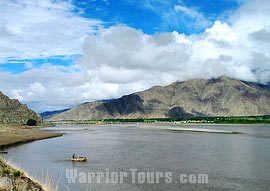Tibet Introduction

Tibet has always been known as 'The Roof of the World'. For millennia it has attracted and enthralled visitors, and touched them with the magic of its mysteries.
Tibet (Tibet Autonomous Region) is situated in the southwest of China bordering the internal provinces of Xinjiang, Qinghai, Sichuan and Yunnan. Externally it is bordered by India, Burma, Bhutan, Sikkim and Nepal. It covers a vast area of 120 sq km. (29,652 acres), standing the second after Xinjiang in China. But it only owns the thinnest population of 2.6 million, more than 90% of which are the Tibetans themselves; other nationalities like Han, Hui, Mongol also found in the two biggest cities of Lhasa, Shigatse and other cities and towns. At the average altitude of over 4,000 m. (13,123 ft.), this region boasts of many huge mountains like Mt. Nyainqentanglha, Karakoram Mountains, Gangdise and Himalayas. The peculiar landscape gives rise to the cold and dry plateau climate in almost all of Tibet except some regions in the south and east like Nyingchi. Despite the adverse conditions, the year-round snow-clad highest mountains still exert a strong pull to mountaineers, adventurers and sightseers near and afar.

![]() Things to Do
Things to Do
Tibet is also magically endowed with many other natural wonders like the twin group of sacred mountain and holy lake - Mt. Kailash and Lake Manasarova, the Heavenly Lake Namtso among others. It is also the cradle of many large rivers such as China's Yangtze River, Yellow River, Yarlong Tsangpo River and India's Indus and Ganges. Most geographical features are on a grand scale and one necessarily feels small and insignificant as one stands before the spectacular canyons, valleys, glaciers, and basins and so on in Tibet.
Tibet is actually a land of natural treasures. A number of natural reserves within the region are the home to many rare and valuable wild animals and plants like lesser pandas, yaks, cranes and virgin cypress, spruces and snowdrops among others. The land also produces large amounts of minerals, water energy, wind energy, terrestrial heat and solar energy. Yangpachen is just the first research center for terrestrial heat in China.

With a recorded history of about 1,300 years, Tibet is also left with many invaluable cultural and historical relics. The majestic Potala Palace, Graveyards of Ancient Tibetan Kings, the once 'Summer Palace' Yumbu Lakhang and mysteriously fragmented Ruins of Guge Kingdom are always well-trodden spots for visitors. Religion is important to each generation of Tibetans. Religious activities of circumambulation, worship, prayers and reciting sutras and other religious concerns are always part of the life of them; hence many temples dot the landscape of Tibet. The grand Jokhang Temple, three largest monasteries of Gelugpa, Ganden Monastery, Drepung Monastery and Sera Monastery, the first temple in Tibet Samye Monastery, the seat of Panchen Lama, Tashilhunpo Monastery and one of the largest monastery of the indigenous Bon, Zezhol Monastery often attract many devout followers and pilgrims.

![]() Travel Tips
Travel Tips
Tibetans are also hospitable and accomplished in singing and dancing and other art forms. Strolling on Barkhor Street, exotic Tibetan costumes, gorgeous Tibetan carpets, superb collections of shining adornments and various delicate handicrafts such as Thangka, masks and knives are really a feast for the eyes. It is also expected to be a marvelous experience to visit Zhangmu Town, a bustling port bordering Nepal and distinctly cross-cultural.
![]() Transportation
Transportation
Since the opening of Qinghai-Tibet Railway and multiple highways and airlines, it has become very convenient to travel from Xinjiang, Qinghai, Yunnan, Beijing, Chongqing, Chengdu, Xian, Guangzhou, Shanghai, Hong Kong and Nepal to Tibet. The scenery along the way is spectacularly breath-taking.

